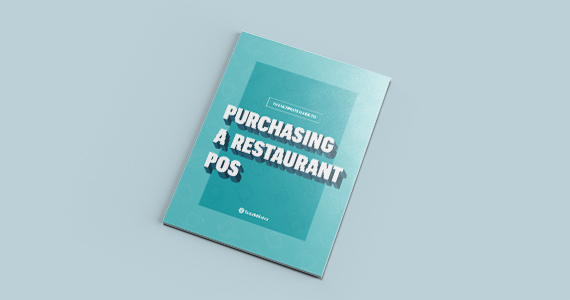Similar to any relationship, whether working or personal, sometimes a relationship has ultimately run its course. As a restaurant operator, one of the most important relationships is with your POS system and provider. And if you’re using a legacy POS system and no longer see the value it adds to your operations, or simply are finding it outdated and slow, it might be time to make the leap and switch POS systems. Switching to a cloud-based POS system can help solve the concerns you have with your legacy system, as well as provide you with the tools to provide quicker service and an all-round more efficient operation.
Before you decide to take the leap of faith and switch providers, our article outlines everything you need to know to ensure a cloud-based POS system is the right solution for your restaurant, including the following:
- The difference between legacy and cloud-based POS systems
- 6 reasons to upgrade to a cloud-based POS system

Legacy vs Cloud-Based POS Systems
Both legacy and cloud-based POS systems serve as essential technology that helps operators unify and streamline operations between the front and back of house. So, what’s the difference between the two?
A legacy POS system, otherwise known as a traditional POS system, is a hardwired system that needs to be physically set-up on-site at your venue. This type of POS system usually requires larger and bulky hardware and the software runs on a closed internal system, with data stored on a local server. In other words, with this type of POS system, your data can only be accessed on-site and in-person – whether that’s pulling sales information for each server or making changes to the staffing schedule.
On the other hand, a cloud-based point of sale (POS) system stores all your business information in online servers and runs remotely via an Internet connection. The benefit of this type of system is that when you want to access your information, you can do so from anywhere at any time, as long as you have an Internet connection. This means you can manage your restaurant menu remotely or view sales data from the comfort of your home – a cloud-based POS system for restaurants gives you that flexibility.
6 Reasons to Upgrade to a Cloud-Based POS System
Now that we’ve covered the difference between a legacy and a cloud-based POS system for restaurants, let’s explore six reasons why upgrading your POS system to a cloud-based one can be a smart move for your business.
1. Cloud-Based Systems are Easier to Set Up
Legacy or traditional POS systems are typically more difficult to set-up and are more costly. For example, it can cost up to $20,000 for a legacy system, including the one-time hardware costs, installation, and monthly support, versus a few thousand dollars for a cloud-based system. This is because there are usually more components required to set up a legacy POS system, specifically the hardware.
If you’re looking for a quality POS system that is both quick to set-up and more budget friendly, a cloud-based system is the right choice for most restaurants. With its simple setup, you can start using all the features it has to offer much quicker. And if there are any fixes and updates required, they can be done more efficiently, as most updates can be completed remotely, versus having to hire a maintenance person to come on-site to make those updates.
2. Cloud-Based Systems are Easy to Use
While legacy POS systems have been around longer, there is much newer software out there that is more familiar and easier to use. For instance, POS software that runs on iOS, is newer and tends to be more familiar to today’s restaurant staff, which can make training staff much smoother. Because of the technology’s age, legacy POS systems can also sometimes lack the functionality that’s required to keep up with the rapid pace of the restaurant industry and make it difficult to add new integrations that suit your restaurant’s needs.
One of the most common cloud misconceptions is that cloud POS systems aren’t user-friendly. However, this couldn’t be further from the truth. Today’s cloud-based POS are designed with the end user in mind, specifically restaurant staff and management. This means the features are built to be intuitive and easy to use in a hectic environment like a dining room or kitchen. Not to mention, many cloud-based POS systems are built on iOS, which many restaurant staff are familiar with and instinctively know how to use. As a result, using a cloud-based POS system in your restaurant can decrease the time spent training employees, decrease miscommunication between staff, and reduce manual order errors.

Get the guide that helps you evaluate different POS solutions and find the right one for your business.
3. Cloud-Based Systems Can Be Accessed Remotely
As much as restaurant owners want the superpower of being physically present in more than one location at the same time, it’s impossible. And since your data can only be used and accessed on-site with a legacy POS system, it can be especially difficult to make important business decisions in real time.
Fortunately, with the power of technology, specifically the Internet, restaurateurs no longer need to be present at their restaurant to access important information. Everything from accessing cloud reporting to making menu changes can be done remotely with a cloud-based POS system since these systems can be accessed remotely, from any device, as long as there is an Internet connection available. Not to mention, you’ll be viewing and making changes in real-time, which ensures you’re able to make crucial decisions as soon as you need to do so.

4. Cloud-Based Systems are More Efficient
Using legacy POS systems can be inefficient, especially with a larger venue, as it requires staff to constantly travel back and forth to a fixed terminal. This can lead to slower service and potentially an increase in manual order errors.
Fortunately, with a cloud-based system, servers can take the POS system with them, because most cloud systems include mobile POS tablets. This allows staff to take orders tableside and input the orders into the system on the spot, which can make submitting orders to the kitchen faster and speed up service. Servers can even send orders to the back of the house and continue processing payments, when you lose an Internet connection, since most cloud-based systems are equipped with offline mode.
5. Cloud-Based Systems Require Less Maintenance
Being a restaurant operator, the more efficient your restaurant operations are, the better, and that includes maintaining your POS system. With legacy systems, you often have to call a technician to come to your restaurant whenever an update is needed or if a bug needs to be fixed. And, if you’re faced with the unfortunate situation that the technology becomes too outdated, you may have to upgrade your entire system (costing you both time and money).
With a cloud-based POS system, most updates and fixes can be done automatically and remotely, so you don’t have to worry about arranging your schedule around having a technician come in to fix your POS system in-person. Because updates roll out automatically with a cloud-based system, your POS will always be updated with the latest fixes to keep your restaurant operations running smoothly at all times.
6. Cloud-Based Systems are Built for Growth
For restaurant operators looking to expand their restaurant empire quickly, using a legacy POS system may hinder your efforts. This is because implementing legacy POS systems often requires more time and money upfront to purchase and install hardware across multiple locations. In addition, legacy POS systems are installed on-premise with restaurant’s data only accessible at the venue itself, which becomes difficult to transfer if you decide to grow your operations. For example, if you want to expand your operations, you’ll have to manually input any menu data, instead of pulling it from a centralized location, like the cloud.
In contrast, cloud-based POS systems tend to be better equipped to transfer data more efficiently, making it easier for restaurateurs to grow their operations. Cloud-based POS systems are also seen as more reliable for multi-unit restaurant locations, due to a more secure infrastructure that can handle large volumes of data and transactions, which can be beneficial when growing your restaurant empire. In short, many cloud-based POS system providers provide high security systems, so as a restaurateur, you can be confident your data is backed up and secure. This is unlike legacy systems, which are much more vulnerable to physical threats. For example, if there is a flood on-premise, you risk your data being lost forever.
You’re now equipped with everything you need to know about whether you should switch POS systems to a cloud-based one, meaning you’re in a good position to make a decision that works for you and your business. Remember, when one door closes, another opens, and perhaps it will be an even better one!

Get the guide that helps you evaluate different POS solutions and find the right one for your business.
Get the Complete Guide to Restaurant Reservations
Sign up for our free weekly TouchBistro Newsletter







